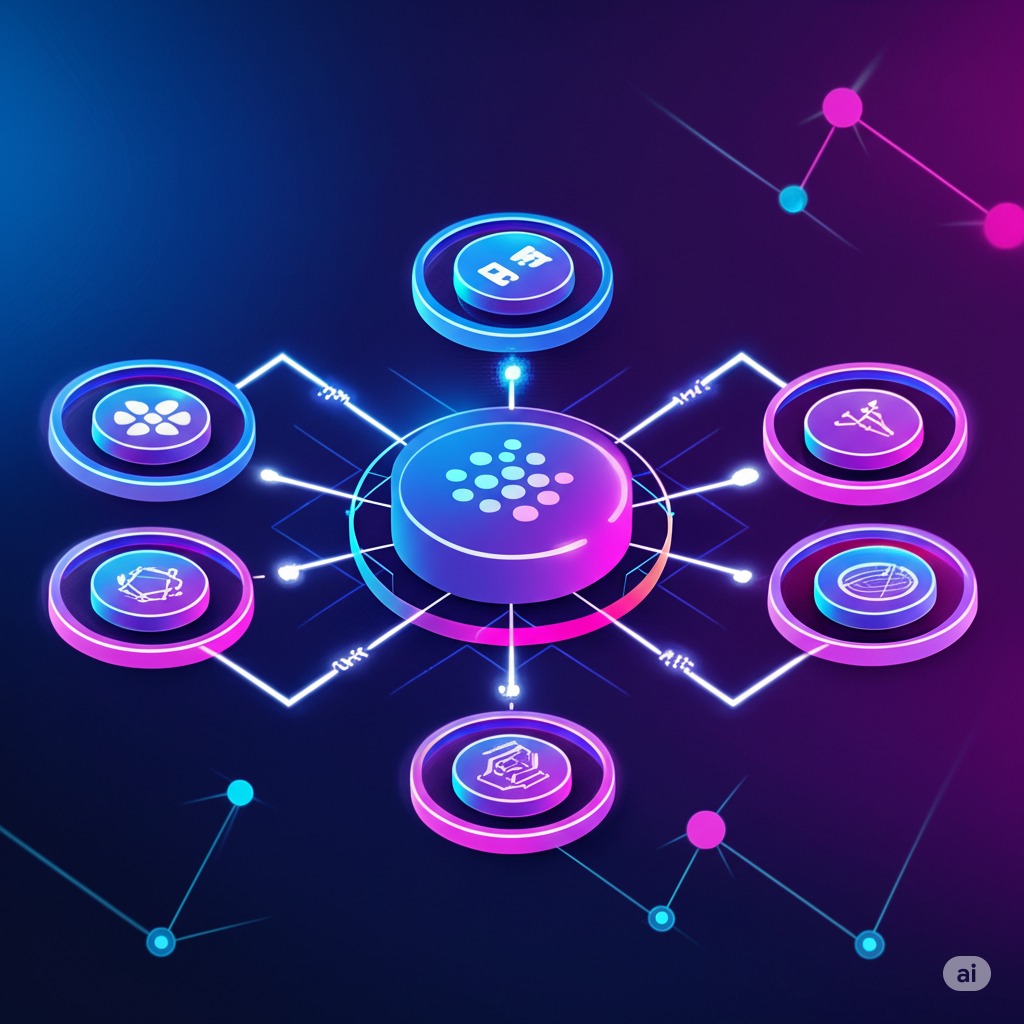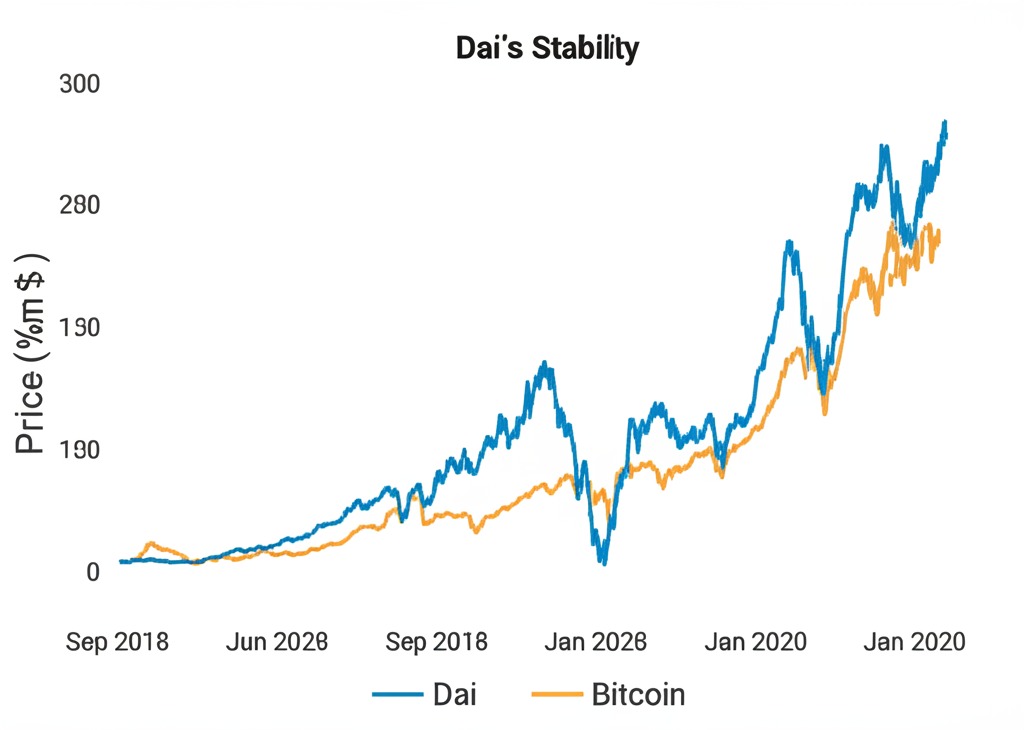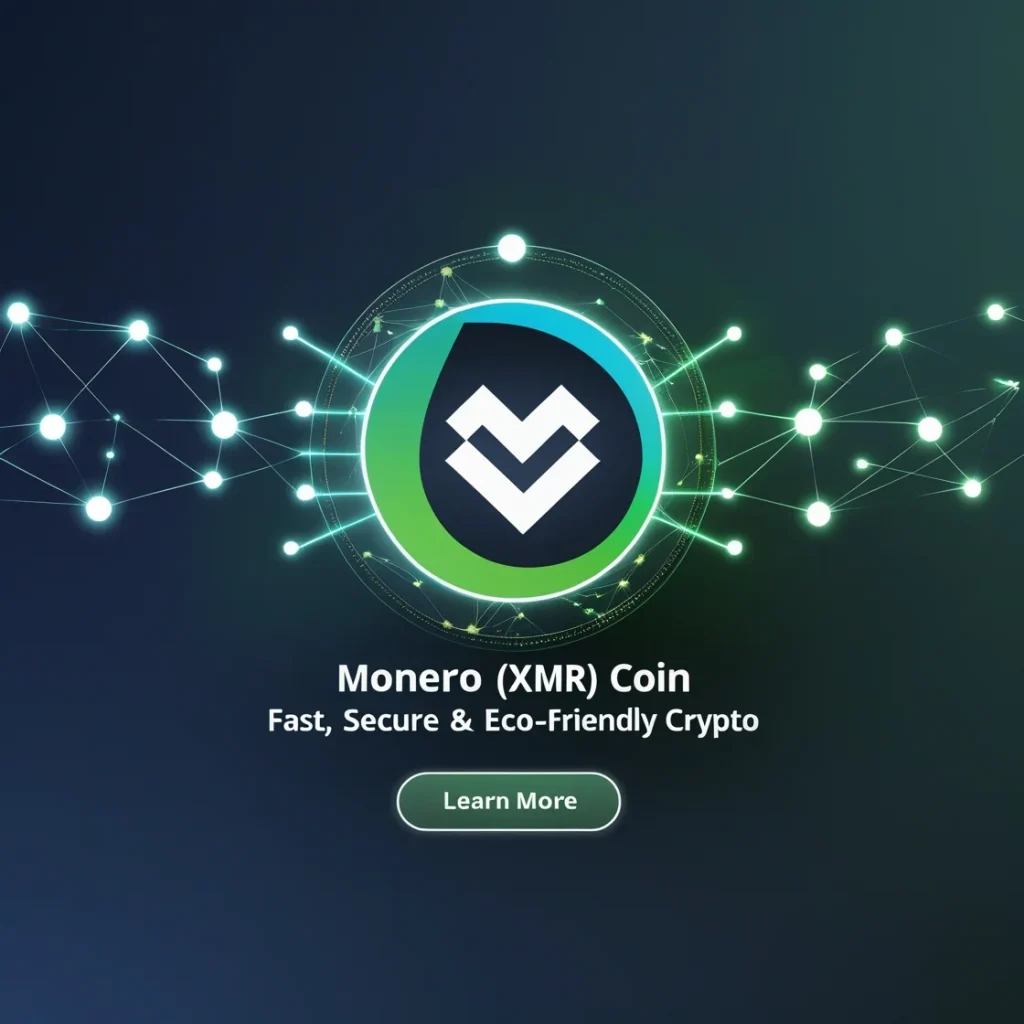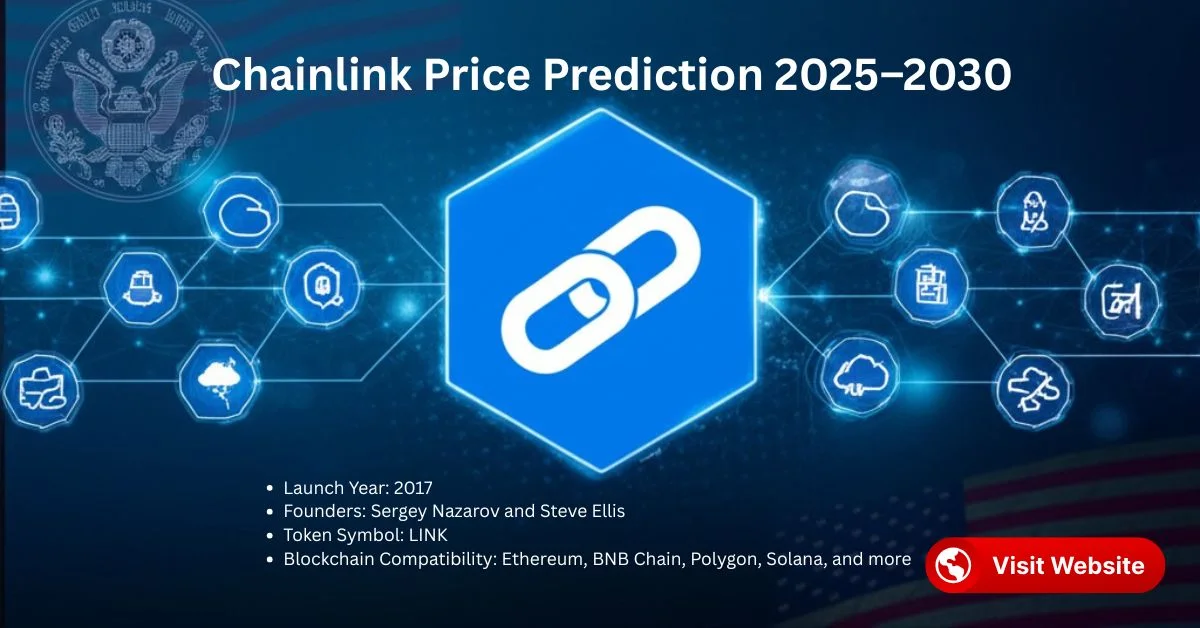Chainlink is a decentralized oracle network that enables smart contracts to securely interact with real-world data, APIs, and payment systems. It bridges the gap between blockchain and external data sources, making decentralized applications more powerful, accurate, and trustworthy.
In the rapidly evolving domain of blockchain and decentralized finance (DeFi), Chainlink has emerged as a linchpin technology — one that facilitates trusted, real-world data integration into on-chain smart contracts. This article explores what Chainlink is, how it works, and why it’s indispensable to the future of Web3.
1. What is Chainlink?
Chainlink is a decentralized oracle network that connects smart contracts with off-chain data sources such as APIs, IoT devices, weather stations, financial markets, and more.
- Launch Year: 2017
- Founders: Sergey Nazarov and Steve Ellis
- Token Symbol: LINK
- Blockchain Compatibility: Ethereum, BNB Chain, Polygon, Solana, and more
Chainlink enables smart contracts to access data that exists outside the blockchain — a major breakthrough for complex decentralized applications (dApps).
2. Why Chainlink Matters in the Blockchain Ecosystem
Without oracles, blockchains are like isolated islands. Smart contracts, by design, can’t access external data unless securely provided by oracles. Chainlink’s secure and tamper-proof oracles make blockchain smarter, more dynamic, and more capable.
Why Chainlink is Crucial:
- Enables smart contracts to react to real-world events
- Increases adoption of decentralized finance (DeFi)
- Supports NFT and gaming ecosystems with reliable data
- Prevents data manipulation and fraud through decentralized nodes
3. How Chainlink Works: A Technical Overview
At the heart of Chainlink lies a decentralized oracle network (DON), which retrieves, validates, and delivers external data to smart contracts. Here’s how it functions step-by-step:
- Data Request Initiated: A smart contract sends a request for external data.
- Chainlink SLA (Service Level Agreement): The request is logged on-chain with specifics.
- Node Selection: Chainlink selects multiple oracles to fulfill the data request.
- Off-Chain Data Fetching: Oracles gather data from various APIs or feeds.
- Data Aggregation: Chainlink Aggregation Contracts combine multiple responses to ensure accuracy.
- Final Submission: The validated data is delivered back to the requesting smart contract.

4. Key Features of Chainlink
Chainlink is equipped with a variety of features that contribute to its versatility and security in data provisioning.
✅ Decentralization
Eliminates single points of failure by sourcing data from multiple independent nodes.
✅ Reputation System
Ranks oracle nodes based on performance, transparency, and reliability.
✅ Data Signing
Ensures authenticity through cryptographic proofs and trusted execution environments.
✅ Chainlink VRF (Verifiable Random Function)
Provides secure and tamper-proof randomness for gaming, NFTs, and lotteries.
✅ Chainlink CCIP (Cross-Chain Interoperability Protocol)
Facilitates seamless messaging and token transfers across blockchains.
5. Chainlink Use Cases
Chainlink has been widely adopted across multiple industries. Here’s a snapshot of real-world applications:
| Industry | Use Case Example |
|---|---|
| DeFi | Price feeds for lending platforms like Aave |
| Insurance | Weather data for parametric insurance |
| Gaming | Fair randomness in blockchain games |
| NFTs | Dynamic NFTs with evolving metadata |
| Enterprise | Data verification in supply chains |
| Governance | Secure on-chain voting mechanisms |
Notable Partners:
- Google Cloud
- SWIFT
- AccuWeather
- Deutsche Telekom
- Associated Press (AP)
6. Chainlink vs. Competitors: A Comparative Table
| Feature | Chainlink | Band Protocol | API3 | DIA |
|---|---|---|---|---|
| Market Cap (Approx.) | $9 Billion+ | ~$200 Million | ~$100 Million | <$100 Million |
| Node Decentralization | High | Medium | Medium | Low |
| Supported Blockchains | 10+ | 5+ | 3+ | 2+ |
| Security Audits | Regular | Yes | Yes | Limited |
| Developer Community | Extensive | Moderate | Small | Niche |

7. Chainlink Token (LINK): Utility and Market Analysis
LINK is the native cryptocurrency used to pay node operators and incentivize honest behavior.
🔹 Use Cases of LINK:
- Payment for oracle services
- Collateral for data accuracy
- Staking (future roadmap)
🔹 Market Metrics (As of June 2025):
- Price: ~$16.40
- Market Cap: $9+ Billion
- Total Supply: 1 Billion LINK
- Circulating Supply: ~587 Million LINK
- Exchanges: Binance, Coinbase, Kraken, KuCoin
High CPC Keywords Associated with LINK:
- “Best crypto to invest 2025”
- “DeFi oracle solution”
- “Web3 token staking”
- “Chainlink price prediction”
- “Blockchain data feeds”
Chainlink (LINK) Price Prediction: 2020 to 2030
| Year | Price Range (USD) | Key Highlights & Market Context |
|---|---|---|
| 2020 | $1.50 – $12.00 | LINK experienced strong growth driven by DeFi boom and increased oracle demand. Significant price rally mid-2020. |
| 2021 | $10.00 – $52.00 | LINK hit its all-time high (~$52) in May 2021 amid crypto market surge. Expansion of partnerships and integrations. |
| 2022 | $7.00 – $26.00 | Market correction due to crypto winter; LINK maintained strong fundamentals and tech development. |
| 2023 | $5.00 – $15.00 | Gradual recovery with wider adoption of Chainlink VRF and CCIP announcements. Steady DeFi ecosystem growth. |
| 2024 | $12.00 – $30.00 | Expected price surge as staking rollout and cross-chain interoperability mature. Growing institutional interest. |
| 2025 | $20.00 – $45.00 | Chainlink solidifies as leading oracle provider; widespread Web3 adoption supports price momentum. |
| 2026 | $30.00 – $60.00 | Expansion into new sectors (IoT, insurance); increased token staking further drives demand. |
| 2027 | $40.00 – $75.00 | Enhanced cross-chain protocols and enterprise contracts push price upward; strong developer ecosystem. |
| 2028 | $50.00 – $90.00 | Chainlink’s infrastructure critical to blockchain adoption; price reflects utility and market cap growth. |
| 2029 | $65.00 – $110.00 | Mainstream DeFi and smart contract adoption; LINK becomes key digital asset in oracle space. |
| 2030 | $80.00 – $150.00+ | Potential market leader in decentralized data provisioning; large-scale integration in finance and government sectors. |
Summary
- Chainlink’s price has shown impressive growth since 2020, fueled by DeFi and oracle demand.
- After correction phases, LINK is projected to appreciate steadily as Web3 adoption expands.
- Innovations like staking and cross-chain protocols are expected to boost LINK’s value significantly.
- By 2030, LINK could reach a high-value range reflecting its foundational role in blockchain infrastructure.
Advanced Chainlink Insights & Updates (2025)
1. Chainlink Staking Progress
- Chainlink is rolling out full staking capabilities beyond its initial phases.
- Staking will enhance network security by economically incentivizing nodes to provide accurate data.
- Stakers can earn rewards while helping secure oracle services—this will drive demand for LINK tokens.
2. Chainlink Cross-Chain Interoperability Protocol (CCIP)
- CCIP is set to become a major blockchain interoperability standard.
- It enables developers to build cross-chain applications seamlessly, bridging Ethereum, Solana, BNB Chain, Polygon, Avalanche, and more.
- This interoperability layer is expected to accelerate decentralized app development, increasing Chainlink’s ecosystem value.
3. Integration with AI and IoT
- Chainlink is exploring or already integrating oracles with AI data feeds and Internet of Things (IoT) sensors.
- This fusion opens new avenues for smart contracts in real-world automation, supply chain management, and autonomous devices.
4. Growing Enterprise Adoption
- More Fortune 500 companies and governments are running pilot programs with Chainlink oracles.
- Reliable, tamper-proof data feeds can improve transparency and reduce fraud in industries such as insurance, logistics, and finance.
5. Regulatory Environment
- While crypto regulations globally remain uncertain, Chainlink’s decentralized model makes it a resilient infrastructure piece.
- LINK is increasingly seen as a utility token rather than a security, which may provide regulatory clarity favorable for adoption.
6. Developer Ecosystem & Community Growth
- Chainlink’s developer community is expanding rapidly, with thousands of projects using its oracle services.
- Regular hackathons, grants, and partnerships keep innovation active and healthy.

Pro Tip for You:
Keep an eye on these upcoming events and developments:
- Chainlink 2.0 Upgrades: Expected to introduce major scalability and security improvements.
- LINK Tokenomics Adjustments: Possible changes in supply and staking rewards structure.
- New Oracle Services: Expansion into predictive analytics, ESG data, and more.
8. Future of Chainlink
Chainlink continues to shape the decentralized internet by expanding its infrastructure and services. Key roadmap elements include:
🛠 Chainlink Staking (v0.2 and beyond)
Incentivizes node honesty and data quality by locking LINK tokens.
🌉 Cross-Chain Connectivity via CCIP
Enables secure and trust-minimized interoperability between chains like Ethereum, BNB, and Solana.
🔗 Chainlink Functions
Allows developers to connect smart contracts with any web API — including AI, machine learning, and IoT devices.
🌎 Institutional Adoption
Increasing use by governments, fintechs, and traditional financial institutions for data provisioning.
9. How to Buy and Store Chainlink (LINK)
Getting started with Chainlink is relatively simple, even for crypto novices.
🛒 How to Buy LINK:
- Choose an Exchange:
- Coinbase (beginner-friendly)
- Binance (advanced trading tools)
- Kraken (secure & regulatory-compliant)
- Deposit Funds: Via bank transfer, card, or crypto
- Purchase LINK: Using USDT, USD, or BTC pairs
🔐 How to Store LINK:
- Hot Wallets:
- MetaMask
- Trust Wallet
- Cold Wallets:
- Ledger Nano S/X
- Trezor Model T
🛡️ Security Tip: Use two-factor authentication and always verify URLs before logging into crypto platforms.

10. Final Thoughts
Chainlink is more than just a “crypto token”—it’s a critical infrastructure layer enabling smart contracts to become truly “smart.” Its real-world applications, enterprise partnerships, and evolving technology stack solidify its position in the future of decentralized ecosystems.
For investors, developers, and technologists alike, Chainlink represents both innovation and stability in the unpredictable world of crypto assets.
💡 Quick Summary
| Feature | Description |
|---|---|
| Project Type | Decentralized Oracle Network |
| Token Name | LINK |
| Primary Use Case | Data Bridge Between Smart Contracts & APIs |
| Key Features | Decentralization, Data Aggregation, VRF |
| Adoption Sectors | DeFi, Gaming, Insurance, Enterprises |
| Staking Available | Partially (Full implementation in progress) |
| High CPC Keywords | Blockchain oracles, Chainlink staking |
📝 Frequently Asked Questions (FAQs)
Q1: Is Chainlink a good investment in 2025?
A1: Chainlink remains a strong contender in the oracle space and is widely integrated across DeFi. As always, do your own research before investing.
Q2: What makes Chainlink different from Band Protocol?
A2: Chainlink has broader adoption, more security layers, and a more decentralized node infrastructure.
Q3: Can I stake LINK tokens?
A3: Yes, Chainlink is rolling out staking mechanisms starting with v0.2.
Q4: Is Chainlink only compatible with Ethereum?
A4: No. Chainlink is blockchain-agnostic and supports multiple ecosystems including Polygon, Solana, and BNB Chain.
